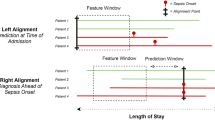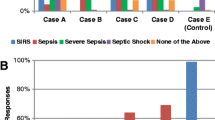Abstract
To quantify a qualitative screening tool for the early recognition of sepsis in children with fever either visiting the emergency department or already admitted to hospital. Prospective observational study including febrile patients under 18 years of age. Sepsis diagnosis was the main outcome. A multivariable analysis was performed with 4 clinical variables (heart rate, respiratory rate, disability, and poor skin perfusion). The cut-off points, odds ratio, and coefficients of these variables were identified. The quantified tool was then obtained from the coefficients. The area under the curve (AUC) was obtained and internal validation was performed using k-fold cross-validation. Two hundred sixty-six patients were included. The multivariable regression confirmed the independent association of the 4 variables with the outcome. The quantified screening tool yielded an excellent AUC, 0.825 (95%CI 0.772–0.878, p < 0.001), for sepsis prediction.
Conclusion: We successfully quantified a sepsis screening tool, and the resulting model has an excellent discriminatory power.
What is Known: |
• Screening tests have to be based only on clinical variables that needs minimum technological support. |
• The current Sepsis Code is a qualitative screening tool. |
What is New: |
• The current screening tool was quantified using four clinical variables, weighted according to the deviation from normality and differentiated according to the age of the patient. |
• The resulting model has an excellent discriminatory power in identifying septic patients among febrile pediatric patients. |
Similar content being viewed by others
Availability of data and material
Not applicable.
Code availability
Not applicable.
Abbreviations
- AUC:
-
Area under the curve
- CI:
-
Confidence interval
- ED:
-
Emergency department
- IQR:
-
Interquartile range
- NPV:
-
Negative predictive value
- PESERS score:
-
PEdiatric SEpsis Recognition and Stratification score
- PPV:
-
Positive predictive value
- qSOFA score:
-
Quick Sequential Organ Failure Assessment Score
- Se:
-
Sensitivity
- SIRS:
-
Systemic inflammatory response syndrome
- SOFA:
-
Sequential Organ Failure Assessment Score
- Sp:
-
Specificity
- UCI:
-
Intensive care unit
References
Benito Fernández J, Luaces Cubells C, Gelabert Colomé G, Anso BI (2015) Actualización del sistema de codificación diagnóstica de la Sociedad Española de Urgencias de Pediatría. An Pediatr 82(6):442.e1-442.e7
Fleischmann-Struzek C, Goldfarb DM, Schlattmann P, Schlapbach LJ, Reinhart K, Kissoon N (2018) The global burden of paediatric and neonatal sepsis: a systematic review. Lancet Respir Med 6(3):223–30. Available from: https://doi.org/10.1016/S2213-2600(18)30063-8
Weiss SL, Peters MJ, Alhazzani W, Agus MSD, Flori HR, Inwald DP et al (2020) Surviving Sepsis Campaign International Guidelines for the Management of Septic Shock and Sepsis-Associated Organ Dysfunction in Children. Intensive Care Med 64(Suppl 1):10–67
Solé-Ribalta A, Launes C, Felipe Villalobos A, Balaguer M, Luaces C, Garrido R et al (2022) New multivariable prediction model PEdiatric SEpsis Recognition and Stratification (PESERS score) shows excellent discriminatory capacity. Acta Paediatr 00:000–000. https://doi.org/10.1111/apa.16321
Yébenes JC, Lorencio C, Esteban E, Espinosa L, Badia JM, Capdevila JA et al (2020) Interhospital Sepsis Code in Catalonia (Spain): territorial model for initial care of patients with sepsis. Med Intensiva 44(1):36–45. Available from: https://doi.org/10.1016/j.medin.2019.05.008
Goldstein B, Giroir B, Randolph A (2005) International pediatric sepsis consensus conference: definitions for sepsis and organ dysfunction in pediatrics. Pediatr Crit Care Med 6(1):2–8
O’Leary F, Hayen A, Lockie F, Peat J (2015) Defining normal ranges and centiles for heart and respiratory rates in infants and children: a cross-sectional study of patients attending an Australian tertiary hospital paediatric emergency department. Arch Dis Child 100(8):733–737
Fleming S, Thompson M, Stevens R, Heneghan C, Plüddemann A, Maconochie I et al (2011) Normal ranges of heart rate and respiratory rate in children from birth to 18 years of age - Supplementary webappendix. Lancet 6736(10):1011–1018
Thompson M, Coad N, Harnden A, Mayon-White R, Perera R, Mant D (2009) How well do vital signs identify children with serious infections in paediatric emergency care? Arch Dis Child 94(11):888–893
Fleming S, Gill P, Jones C, Taylor JA, Van Den Bruel A, Heneghan C et al (2015) The diagnostic value of capillary refill time for detecting serious illness in children: a systematic review and meta-analysis. PLoS ONE 10(9):1–15
Singer M, Deutschman CS, Seymour C, Shankar-Hari M, Annane D, Bauer M et al (2016) The third international consensus definitions for sepsis and septic shock (sepsis-3). JAMA J Am Med Assoc 315(8):801–810
Lloyd JK, Ahrens EA, Clark D, Dachenhaus T, Nuss KE (2018) Automating a manual sepsis screening tool in a pediatric emergency department. Appl Clin Inform 9(4):803–808
Author information
Authors and Affiliations
Contributions
A. Solé-Ribalta conceptualised and designed the study, designed the data collection instrument, collected the data, carried out the initial analysis, and drafted the initial manuscript. M. Balaguer, S. Bobillo- Pérez, M. Girona Alarcón, and C. Guitart contributed to the data collection and analysis. E. Esteban and I. Jordan conceptualised and designed the study and critically reviewed the manuscript. All the authors have approved the final manuscript as submitted and agree to be accountable for all aspects of the work.
Corresponding author
Ethics declarations
Ethics approval
The study and its database were approved and declared safe by the Hospital Sant Joan de Déu ethics committee and by the institutional review board. The study followed the principles of the Declaration of Helsinki.
Consent to participate
Parents or legal guardians of children younger than 12 years old were required to sign the informed consent document before their children were included. Participants older than 12 years had to sign an additional informed consent in addition to the one signed by their legal guardians.
Consent for publication
Parents or legal guardians of children younger than 12 years old were required to sign the informed consent document before their children were included. Participants older than 12 years had to sign an additional informed consent in addition to the one signed by their legal guardians.
Conflict of interest
None of the authors have conflicts of interest to disclose.
Additional declarations for articles in life science journals that report the results of studies involving humans and/or animals
No additional declarations for this study.
Additional information
Communicated by H. Babaie.
Publisher's Note
Springer Nature remains neutral with regard to jurisdictional claims in published maps and institutional affiliations.
Rights and permissions
Springer Nature or its licensor (e.g. a society or other partner) holds exclusive rights to this article under a publishing agreement with the author(s) or other rightsholder(s); author self-archiving of the accepted manuscript version of this article is solely governed by the terms of such publishing agreement and applicable law.
About this article
Cite this article
Solé-Ribalta, A., Balaguer, M., Bobillo-Pérez, S. et al. Quantification of a qualitative sepsis code: laying the foundations for the automation revolution. Eur J Pediatr 182, 2169–2172 (2023). https://doi.org/10.1007/s00431-023-04867-8
Received:
Revised:
Accepted:
Published:
Issue Date:
DOI: https://doi.org/10.1007/s00431-023-04867-8




